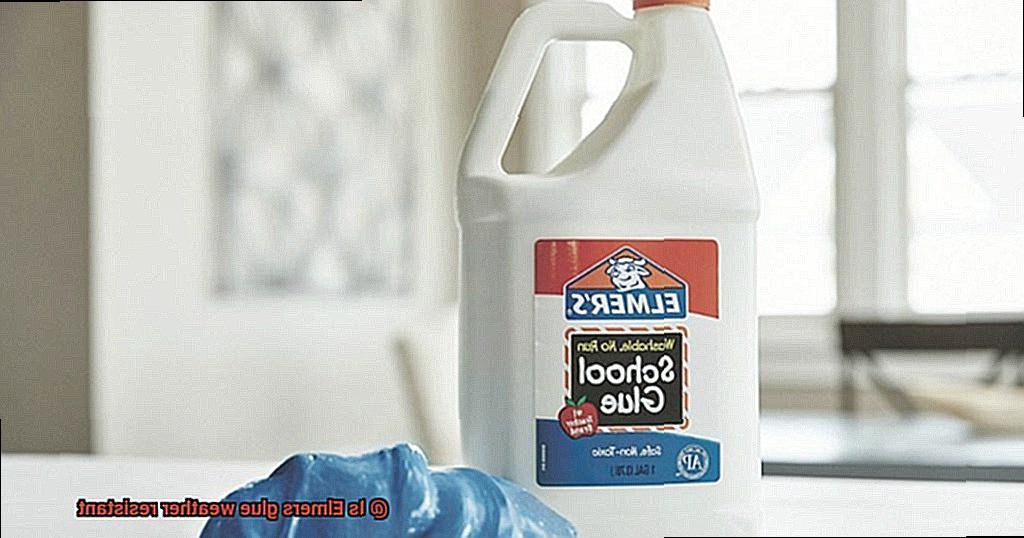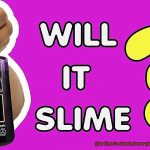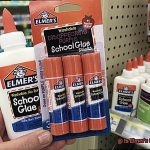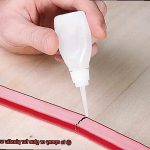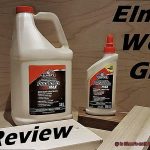Do you find yourself frustrated with all the hard work you put into your DIY projects only for them to be ruined by sudden changes in weather? It’s a common challenge faced by creative enthusiasts everywhere. But don’t give up just yet. The solution to your problem may be as simple as choosing the right glue.
Enter Elmer’s glue, a classic adhesive that has been trusted by crafters for decades. But can it stand up to the elements? Is Elmer’s glue truly weather-resistant? These are important questions that anyone hoping to create long-lasting projects should ask themselves.
In this blog post, we’ll take a deep dive into Elmer’s glue and explore its weather-resistant properties. We’ll uncover the science behind its adhesive qualities and how they can be affected by different weather conditions. Plus, we’ll explain why having a weather-resistant glue is crucial and how it can save you time and money in the long run.
Whether you’re an experienced crafter or just starting out, this post will provide you with valuable information to help you make an informed decision about your glue choice. So let’s get started and find out if Elmer’s glue is up for the challenge of unpredictable weather conditions.
What is Elmer’s Glue?
Contents
- 1 What is Elmer’s Glue?
- 2 Is Elmer’s Glue Weather Resistant?
- 3 How Does Elmer’s Glue React to Moisture and Humidity?
- 4 Ways to Make Elmer’s Glue More Weather-Resistant
- 5 The Benefits of Making Elmer’s Glue Weather-Resistant
- 6 Common Sealants and Coatings for Making Elmer’s Glue More Weather-Resistant
- 7 Common Mistakes When Using Elmer’s Glue Outdoors
- 8 Alternatives to Elmer’s Glue for Outdoor Projects
- 9 Conclusion
For over 70 years, Elmer’s Glue has been a household name, trusted by schools and families alike. This popular brand of adhesive is made from a combination of water, polyvinyl acetate (PVA), and other additives. Its versatility makes it suitable for use on various materials such as paper, cardboard, fabric, and wood.
Elmer’s glue comes in different forms, including white school glue, clear glue, and washable glue. The white school glue is the most common type and is perfect for school projects and crafting. Clear glue is often used for decorative purposes like creating slime or adding a glossy finish to artwork. On the other hand, washable glue is ideal for children as it can be easily cleaned up with water.
One of the benefits of Elmer’s Glue is that it dries clear and can be sanded or painted over once it has dried. However, it may not be suitable for all projects as it may not hold up well under extreme weather conditions or on certain materials.
When exposed to heavy rain, snow, or extreme heat, Elmer’s Glue may lose its adhesive properties and deteriorate over time. Although it is water-resistant to some extent, it is not entirely waterproof or weatherproof.
If you need to make your Elmer’s Glue more weather-resistant, there are several ways to do so. A common method is by mixing it with baking soda or cornstarch to create a paste that dries hard and can resist moisture and heat better than traditional Elmer’s Glue. You can also use special sealants or coatings to create a barrier around the glue, protecting it from moisture and other environmental factors.
Is Elmer’s Glue Weather Resistant?
Elmer’s glue is not entirely weather-resistant. When exposed to moisture, rain, or extreme temperatures for extended periods, the adhesive properties of the glue may deteriorate. Therefore, if you want to use Elmer’s glue for your outdoor decorations or in areas that are susceptible to moisture, it may not hold up well over time.
However, fret not. There are some excellent weather-resistant options available from Elmer’s such as the Carpenter’s Wood Glue Max and the ProBond Advanced formula. These products are specially designed to provide a robust bond even under extreme conditions like high humidity or temperature changes. Furthermore, they can withstand exposure to rain and moisture without breaking down or losing their adhesive properties.
Nevertheless, before you rush out to purchase these weather-resistant options, remember that proper application and surface preparation are essential for achieving optimal results. The surfaces being bonded should be clean and dry before applying the glue. Additionally, the glue should be applied evenly and in the correct amount according to the manufacturer’s instructions.
How Does Elmer’s Glue React to Moisture and Humidity?
You may be wondering how it reacts to moisture and humidity. It’s a common concern, and we’re here to help you out.
First things first, Elmer’s glue is primarily made up of polyvinyl acetate (PVA), a water-soluble polymer. This means that it will break down when exposed to moisture or water. So, if you’re planning to use Elmer’s glue for an outdoor project or in a high-humidity environment, it’s essential to choose the right type of glue.
Luckily, Elmer’s offers a variety of options that cater to different needs. For instance, if you’re looking for a water-resistant option, Elmer’s Carpenter’s Wood Glue Max is designed to withstand exposure to moisture and humidity without breaking down. This option is perfect for outdoor projects or those that may be exposed to moisture.
On the other hand, if you’re using Elmer’s School Glue for an indoor project where moisture is not an issue, you’ll be just fine. However, it’s essential always to read the label on the product carefully and choose a glue that is appropriate for your specific needs.
It’s not just about choosing the right type of glue; proper surface preparation is also key to achieving optimal results. So, make sure your surfaces are clean and dry before applying any glue. This will ensure that the glue adheres well and doesn’t break down due to moisture or humidity.
Ways to Make Elmer’s Glue More Weather-Resistant
Elmer’s glue is a versatile adhesive that is commonly used in arts and crafts projects. However, when exposed to harsh weather conditions, it may not hold up well. Fortunately, there are several ways to make Elmer’s glue more weather-resistant. Here are five methods you can try:
Mix with Water-Resistant PVA Glue
Polyvinyl acetate (PVA) glue is water-resistant and adding a small amount of it to Elmer’s glue can help strengthen the bond and make it more resistant to moisture.
Apply a Sealant or Varnish
After the glue has dried, applying a sealant or varnish over the top can protect it from water and other weather-related damage.
Mix with Acrylic Paint
Adding acrylic paint to Elmer’s glue not only adds color but also provides an extra layer of protection against the elements.
Use Stronger Types of Elmer’s Glue
Elmer’s Max Tacky Adhesive is a stronger type of glue that can better withstand harsh outdoor conditions.
Apply a Protective Coating
Applying a clear acrylic spray or polyurethane sealer over the glue after it has dried creates a barrier that protects it from water damage, discoloration, and other forms of deterioration.
It’s important to note that while these methods can make Elmer’s glue more weather-resistant, it’s still important to take precautions when using it in situations where it may be exposed to water or harsh weather conditions. Direct exposure to sunlight or extreme temperatures should be avoided, and any leftover glue should be stored in a cool, dry place.

The Benefits of Making Elmer’s Glue Weather-Resistant
Elmer’s has developed a line of weather-resistant glues that will put your mind at ease.
With specially formulated additives, Elmer’s weather-resistant glue is designed to withstand water, heat, and cold. This means that you can use it for a variety of outdoor projects without fear of it breaking down or losing its adhesive properties. Imagine creating a stunning art piece that can shine through rain or shine, or repairing outdoor furniture with confidence that it will remain intact even in harsh conditions.
Using Elmer’s weather-resistant glue can also save you time and money in the long run. If you use a regular glue for an outdoor project and it fails due to exposure to the elements, you will have to redo the entire project using a different adhesive. However, if you use a weather-resistant glue from the start, you can avoid this problem entirely and save yourself both time and money.
But how do you make your Elmer’s glue weather-resistant? There are several easy methods, including mixing it with water-resistant PVA glue, applying a sealant or varnish, adding acrylic paint, using stronger types of Elmer’s glue, and applying a protective coating. These methods are simple yet effective in making your Elmer’s glue withstand harsh weather conditions.
Common Sealants and Coatings for Making Elmer’s Glue More Weather-Resistant
Fear not, for Elmer’s weather-resistant glue is here to save the day. But what if you want to take it up a notch and make your projects even more durable? Look no further than these common sealants and coatings.
First on the list is Mod Podge, a beloved product among crafters. Not only does it work as a glue, but it also acts as a water-resistant sealer. With its clear finish, Mod Podge is perfect for projects where appearance matters.
Polyurethane is another popular choice for weatherproofing Elmer’s glue. This transparent coating is highly durable and protects against both moisture and UV rays. Applying multiple layers of polyurethane can create an impenetrable barrier.
If flexibility is what you’re after, then silicone sealant should be on your radar. This product creates a waterproof seal that bends with whatever surface it’s applied to. Simply apply the sealant directly onto the glue and wait for it to dry before exposing it to the elements.
Last but not least, acrylic spray sealer is perfect for those who are short on time. This spray-on product dries almost instantly, creating a clear protective layer over the glue. It’s ideal for projects that need to be weatherproofed quickly and with minimal fuss.
Common Mistakes When Using Elmer’s Glue Outdoors
This versatile adhesive is a champion in the crafting world, but there are some common mistakes that people make when using it outdoors.
First and foremost, surface preparation is key. Before applying any glue, ensure that the surface is clean, dry, and free of debris or contaminants. Dirt or moisture can weaken the bond and result in a project that falls apart.
Another mistake to avoid is improper application of glue. Applying too much may lead to a messy, uneven finish, while too little can cause a weak bond that won’t withstand outdoor elements like wind, rain, and sunlight.
To ensure a strong bond, proper clamping pressure is essential. Apply enough pressure during the clamping process to allow the glue to set properly. Insufficient pressure could weaken the bond and lead to eventual failure.
Finally, be mindful of extreme weather conditions when using Elmer’s glue outdoors. High humidity or freezing temperatures can compromise the bonding process. Always check the weather before starting your project and ensure that temperature and humidity levels are within the recommended range.
Alternatives to Elmer’s Glue for Outdoor Projects
But when it comes to outdoor projects, Elmer’s glue might not be the best option due to its lack of weather resistance. Don’t worry though, there are several alternatives that can withstand the elements and provide a strong bond.
First on the list is Gorilla Glue, a popular choice known for its ability to bond to almost any surface and withstand extreme temperatures, moisture, and UV rays. It even expands as it dries, filling any gaps or cracks in your project.
Another excellent option is E6000 Craft Adhesive, which is waterproof and heat-resistant. It creates a flexible bond that won’t crack or break under stress, making it perfect for projects that will be exposed to the elements.
If you’re looking for an eco-friendly option, Titebond III Ultimate Wood Glue is a great choice. Made from natural ingredients, it’s waterproof and has a strong bond that can withstand both hot and cold temperatures.
Lastly, there’s polyurethane glue like PL Premium. This type of glue forms a strong bond that can withstand extreme weather conditions and is resistant to water and chemicals.
When choosing an alternative to Elmer’s glue for your outdoor projects, prioritize weather resistance and long-lasting bonds. These options provide just that while still offering ease of use and versatility.
lqzM0SrIlwk” >
Also Read: Is Elmer’s Glue Waterproof?
Conclusion
In summary, Elmer’s glue is a tried-and-true adhesive that has been a favorite of crafters for generations. However, it may not be the best choice for all projects as it can struggle to maintain its hold under severe weather conditions or on specific materials. When subjected to heavy rain, snow or extreme heat, Elmer’s Glue may lose its adhesive properties and break down over time. Yet, there are several ways to enhance the weather-resistance of Elmer’s glue.
For those seeking a more robust bond in challenging conditions, Elmer’s Carpenter’s Wood Glue Max and ProBond Advanced formula are excellent options. These products are specifically designed to provide an enduring bond even under extreme circumstances like high humidity or temperature changes. Proper application and surface preparation are crucial for achieving optimal results.
Using weather-resistant glue from the outset can save you both time and money in the long run. If you utilize regular glue for an outdoor project and it fails due to exposure to the elements, you will have to redo the entire project with a different adhesive. However, if you opt for weather-resistant glue from the start, you can avoid this problem entirely.
Fortunately, there are alternatives to Elmer’s glue that can withstand harsh elements and provide a durable bond such as Gorilla Glue, E6000 Craft Adhesive, Titebond III Ultimate Wood Glue and polyurethane glue like PL Premium. Selecting one of these options will ensure your project remains intact even in adverse conditions.
In conclusion, while Elmer’s glue is an excellent adhesive option for many crafting projects, it may not be suitable for all situations. By selecting weather-resistant glues like Elmer’s Carpenter’s Wood Glue Max or exploring alternative adhesives like Gorilla Glue or E6000 Craft Adhesive, your project will remain secure even in harsh environments.

